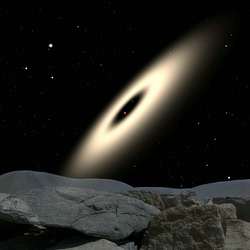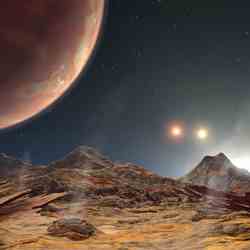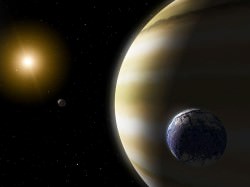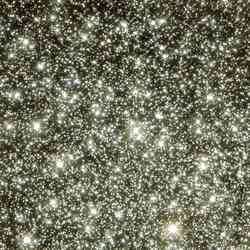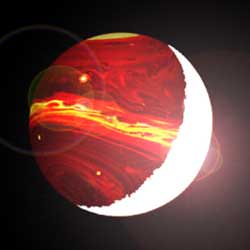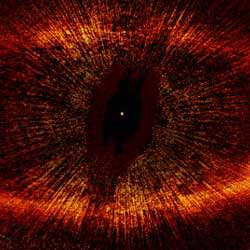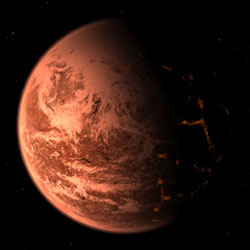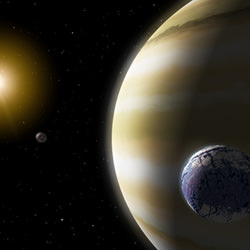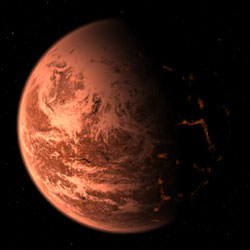
Artist illustration of the rocky planet around the M dwarf Gliese 876. Image credit: NSF. Click to enlarge.
In the land rush known as extrasolar planet hunting, the most prized real estate is advertised as “Earth-like.” On Monday, June 13, scientists raced to plant their flag on a burning hunk of rock orbiting a red star.
This newly discovered planet is about seven times the mass of Earth, and therefore the smallest extrasolar planet found to orbit a main sequence, or “dwarf” star (stars, like our sun, that burn hydrogen).
There are even smaller planets known to exist beyond our solar system, but they have the misfortune to encircle pulsars, those rapidly spinning husks of dying stars. Such planets aren’t thought to be remotely habitable, due to the intense radiation emitted by pulsars.
Planets that are ten Earth masses or less are thought to be rocky, while more massive planets are probably gaseous, since their stronger gravity means they collect and retain more gas during planetary formation. 155 extrasolar planets have been found so far, but most of them have masses that are more comparable to gaseous Jupiter than rocky Earth (Jupiter is 318 times the mass of Earth).
Although this new planet is advertised as Earth-like because of its relatively low mass, earthlings wouldn’t want to rent a house there any time soon. For one thing, the house would melt. The surface temperatures estimated for this planet – 200 to 400 degrees Celsius (400 to 750 degrees Fahrenheit) – are due to the planet’s kissing-close distance from its star.
The planet resides a mere 0.021 AU from the star Gliese 876 (1 AU is the distance between the Earth and the sun), and completes an orbit in less then two Earth days. The closest planet to the sun in our own solar system – blazing hot Mercury – is nearly 20 times further away, orbiting at about 0.4 AU.
“Because the planet is in a two-day orbit, it is heated to oven-like temperatures, so we do not expect life,” says science team member Paul Butler of the Carnegie Institution of Washington.
In our solar system, the habitable zone – the temperate region where water could exist as a liquid on a planet’s surface – is roughly 0.95 to 1.37 AU, or between the orbits of Venus and Mars. The star Gliese 876 is about 600 times less luminous than our sun, so the proposed habitable zone is much closer in, roughly between 0.06 and 0.22 AU.
At 0.021 AU, the new planet is too close to the star to be in the habitable zone, and it also is subjected to greater amounts of high energy radiation like ultraviolet light and X-rays. While red dwarfs like Gliese 876 emit lower levels of UV than stars like our sun, they do emit violent X-ray flares.
Another complication from such a close orbit is that the planet may be tidally locked, with the same side of the planet always facing the star. Unless there is a substantial atmosphere to distribute heat, one side of the planet will be overcooked while the other will remain cold.
Gliese 876 is thought to be about 11 billion years old, making it more than twice as old as our sun. But in a way, Gliese is a teenager to our sun’s middle-aged adult. G-class stars like our sun live about 10 billion years, while M-class red dwarfs are thought to live for 100 billion years (older than the age of the universe!).
Science team member Geoff Marcy of the University of California, Berkeley, says that M stars take a long time to cool off and shrink down to their main sequence size and luminosity. He says that if the planet migrated inwards to its present day close orbit, it probably made this move during the first few million years, and then was subjected to much more radiation than at present for hundreds of millions of years.
Gliese 876 is thought to be metal-poor (to an astronomer, any element heavier than hydrogen and helium is classified as a “metal”). The formation of planets may be related to the metallicity of the star, since both the star and the planets form from the same original material. So a rocky planet like the Earth, made out of elements such as silicates and iron, is expected to orbit a star that is metal-rich.
Despite being metal-poor, Gliese 876 is a multiple planet system. Two gas giant planets are known to orbit Gliese 876: the outermost planet is nearly twice the mass of Jupiter, and orbits at 0.21 AU; the middle planet is about half the mass of Jupiter, orbiting at 0.13 AU.
“The whole planetary system is sort of a miniature of our solar system,” says Marcy. “The star is small, the orbits are small, and in closer is the smallest of them, just as the architecture is in our own solar system, with the smallest planets orbiting inward of the giants.”
We have a lot more elbow room in our solar system. Mercury is further away from the sun than the distances of all these planets combined. The planets in the Gliese 876 system are so close together, they gravitationally interact with each other. This sort of gravitational tug of war was how the scientists were able to detect the planets in the first place.
Over the course of an orbit, planets will gravitationally pull on their star from different sides. Scientists measure the resulting shift in star light to determine the existence of orbiting planets.
To learn more about Gliese 876’s smallest planet, scientists would need to use another planet-hunting technique called transit photometry. This method looks at how a star’s light seems to dip when a planet passes in front of the star from our field of view. The eclipse of the orbiting planet allows astronomers to determine that planet’s mass and radius. Pinning down those numbers indicates the planet’s density, which then suggests what the planet is made of, and whether the planet is rocky or gaseous.
Transit photometry can’t be used to tell us anything about planets orbiting Gliese 876, however, because the system is inclined 50 degrees from our point of view. This angle means the planets won’t block any of the starlight that reaches Earth.
Red dwarfs are the most common type of star in our galaxy, comprising about 70 percent of all stars. Yet out of the 150 red dwarfs they have studied over the years, Marcy and Butler only have found planets orbiting two of them. Because most of the planets found so far are gas giants, this could mean that red dwarfs are less apt to harbor those kinds of worlds.
Marcy says they will continue to monitor Gliese 876 for any hints of a fourth or fifth planet. “This will definitely be one of our favorite stars from now on.”
A Race to the Finish Line
The research paper describing this discovery has been submitted to the Astrophysical Journal. The scientists say they received a favorable preliminary referee’s report, and they expect their paper will be accepted and then published in a few months. During Monday’s press conference, the scientists were asked why they decided to publicize their finding now, before the paper had been accepted for publication. Was it done to beat out other planet hunters who might be hot on their heels?
Marcy replied that they wanted to prevent news of their discovery from leaking out. “We knew about it three years ago, we’ve been following it quietly, carefully, guarding the secret while we double and triple checked. Then about a month ago I talked with Michael Turner here, people at NSF (National Science Foundation), and jointly we decided that this discovery was so extraordinary, maybe what you would call a milestone in planetary science, that it was difficult to imagine keeping the lid on this for very much longer. So we decided that rather than have it leak out to the news media, and be dribbled around, with one newspaper learning about it early and so on, that it would be better to quickly announce this.”
Marcy then launched into a defense for why he believed their finding is correct, and he was quickly backed by his fellow team members. However, the accuracy of their finding had not been questioned. Perhaps their early announcement, combined with the need for secrecy beforehand, is evidence of the intense competition that has marked planet hunting since the beginning.
The first extrasolar planet discovery was announced October 5, 1995 by Michel Mayor and Didier Queloz of the Geneva Observatory, and Marcy and Butler confirmed the observations the following week. A recent example of the competition to grab other extrasolar planet “firsts” occurred last summer, when on August 25, 2004, Mayor, Nuno Santos, and colleagues announced the discovery of the first extrasolar Neptune-mass planet — at the time the smallest extrasolar planet known to orbit a sun-like star. This announcement came less than a week before two other Neptune-mass planet discoveries were announced by Marcy and Butler.
Mayor and his colleagues also have studied Gliese 876. At an astronomy conference in June 1998, Mayor and Marcy each independently announced the detection of the more massive gas giant orbiting this star. Marcy and Butler were first to follow up on this finding, announcing the discovery of the star’s second gas giant planet in 2001.
The Kepler mission, due to launch in June 2008, will search for terrestrial planets orbiting distant stars. The mission defines an Earth-size planet as being between 0.5 and 2.0 Earth masses, or between 0.8 and 1.3 Earth’s diameter. Planets between 2 and 10 Earth masses, such as the planet announced on Monday, are defined as Large Terrestrial planets.
Original Source: NASA Astrobiology
